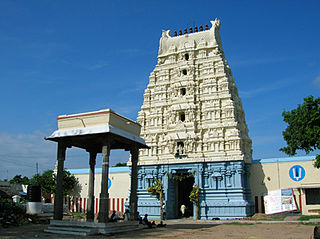
Thirunindravur is a neighbourhood situated on the western part of Chennai district, Tamil Nadu, India. It is located around 29 km from Chennai Central railway station. Thirunindravur comes under Chennai Metropolitan Area. The neighbourhood is served by Thirunindravur railway station. It is famous for its temples. Thiruninravur lake serves the neighbourhood for its water needs. It serves as the connecting hub between Chennai and Tirupati.
Sankarankovil is a Town in the Tenkasi district in the Indian state of Tamil Nadu. It was formerly known as Sankaranayinarkoil. Sankarankovil is the home to the Sankara Narayanar Temple.

Aravakurichi is a panchayat town and a Taluk headquarters in Karur district in the state of Tamil Nadu, India. Aravakurichi is well known in Tamil Nadu as a major market for Moringa oleifera vegetable. Aravakurichi is the headquarters of Aravakurichi taluk which consists of 40 revenue Villages.
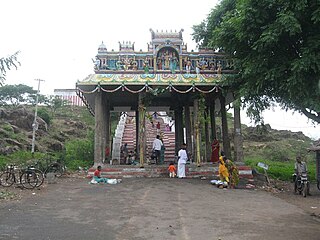
Kundrathur is a town located in the Chennai Metropolitan Area and the headquarters of Kundrathur taluk in Kanchipuram District. It is the birthplace of Sekkizhar, a well-known poet-saint who authored the Periyapuranam.

Madurantakam is the southernmost suburb of Chennai city and a municipality in Chengalpattu district in the Indian state of Tamil Nadu. The town is known for the artificial and second largest lake in Tamil Nadu, the Madurantakam lake. It is said to have been built by the Chola King Uttama Chola, also called as Maduranthaka, during his reign. It is also home to the Eri-Katha Ramar Temple. As of 2011, the town had a population of 30,796.
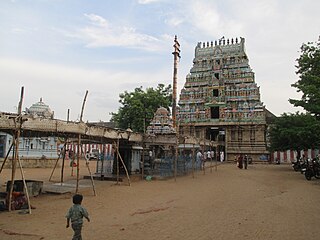
Thirunageswaram is a panchayat town in Thanjavur district in the Indian state of Tamil Nadu. Thirunageswaram is located 6 km east of Kumbakonam. It is the suburban region of business city of Kumbakonam.
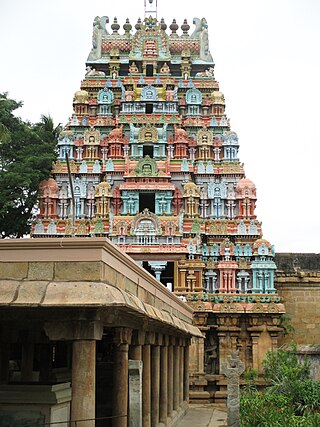
Jambukeswarar Temple, Thiruvanaikaval is a temple of Shiva in Tiruchirapalli (Trichy) district, in the state of Tamil Nadu, India. and one of the five major Shiva Temples of Tamil Nadu representing the Mahābhūta or five elements; this temple represents the element of water, or neer in Tamil. The sanctum of Jambukeswara has an underground stream.

Sikkal Singara Velar Temple is one of the most popular Hindu temples dedicated to Lord Muruga and a contender for the not unofficial seventh Padaiveedu of Muruga, along with the popular Arupadaiveedu.
Pichatur is a village in Tirupati district of the Indian state of Andhra Pradesh. It is the mandal headquarters of Pitchatur mandal.

Suryanar Kovil is a Hindu temple dedicated to the deity Hindu Sun-God, Surya, located in Suryanar Kovil, a village near the South Indian town of Kumbakonam Thanjavur District in Tamil Nadu, India. The presiding deity is Suriyanar, the Sun and his consorts Ushadevi and Pratyusha Devi. The temple also has separate shrines for the other eight planetary deities. The temple is considered one of the nine Navagraha temples in Tamil Nadu. The temple is one of the few historic temples dedicated to Sun god and is also the only temple in Tamil Nadu which has shrines for all the planetary deities.

Apatsahayesvarar Temple, Alangudi or Guru Sthalam or Tiru Irum Poolai is a Hindu temple dedicated to Shiva located in the village of Alangudi in the Valangaiman taluk of Tiruvarur district, Tamil Nadu, India. Shiva is worshipped as Apathsahyesvarar, and is represented by the lingam. His consort Parvati is depicted as Elavarkuzhali. The presiding deity is revered in the 7th century Tamil Saiva canonical work, the Tevaram, written by Tamil saint poets known as the Nayanmars and classified as Paadal Petra Sthalam.

Sattainathar temple, Sirkazhi is a Hindu temple dedicated to Shiva located in Sirkali, Tamil Nadu, India. The temple is incarnated by the hymns of Thevaram and is classified as Paadal Petra Sthalam. It is an ancient temple complex with three different Shiva shrines in three stories.

Thirukkadaiyur (Thirukadavur) is a village on the east coast of Tamil Nadu, about 300 km south of Chennai and 15 km north of Karaikal. The history of the village is associated with the legends of Markandeya and Abirami Pattar. The village is centered around Amritaghateswarar - Abirami Temple of Tirukkadaiyur, a replica. The original temple, Thirumeignanam Gnanaparameswarar Temple, called Thirumeignanam, built in the 11th century, was ravaged by the sea, and is in ruins now. People worship and pray at Thirukkadaiyur temple to have a longer life.

Sakshinatheswarar Temple or Thiruppurambiyam Temple is a Hindu temple dedicated to the God Shiva located in Thiruppurambiyam, Tamil Nadu, India. Shiva is worshipped as Sakshinathar, and is represented here by a Lingam. His consort, Parvati, is depicted as Ikshuvani. The presiding deity is revered in the 7th century Tamil Saiva canonical work, Thevaram, written by Tamil saint poets, known as the Nayanmaars and classified as Paadal Petra Sthalam.

The Karaneeswarar Temple is a 12th-century Hindu temple in the neighbourhood of Mylapore in Chennai, India. The temple is dedicated to Shiva as Karaneeswarar. There are also shrines to Sarvamangala Vinayaka (Ganesha), Dandapani (Kartikeya), Durga, Lakshmi and Saraswati.

Emerald Lingams are established in many Hindu Temples in Tamil nadu.
Spatika Lingam or Crystal Lingamor Crystal Shivling is a type of Lingam made from quartz. Spatika Lingam is called sphatika Sivalingam, ,(Kannada -ಸ್ಪಟಿಕ ಲಿಂಗ),. Sphatikam in Sanskrit means "made of crystal, crystalline", referring to quartz and alum.
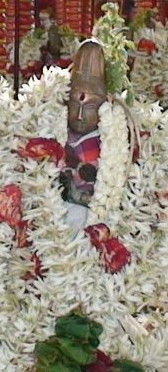
Tirunilanakka Nayanar, also known Tiruneelanakka, Nilanakkar and Nilanakkan, was a Nayanar saint, venerated in the Hindu sect of Shaivism. He is generally counted as the twenty-eighth in the list of 63 Nayanars. He is described as a contemporary of Sambandar, one of the most prominent Nayanars.
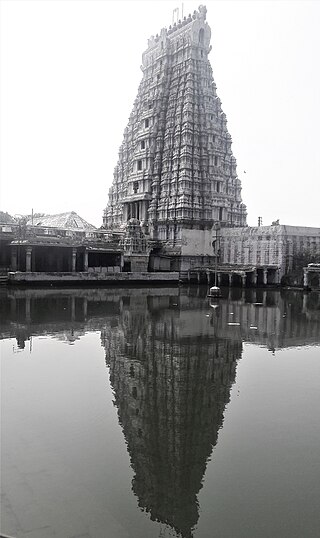
Madavar Vilagam Vaidyanathar temple is a Shiva temple located in Madavar Vilagam, located in one kilometer southerly to Srivilliputhur in Virudhunagar district in the South Indian state of Tamil Nadu, is dedicated to the Hindu god Shiva. Constructed in the Dravidian style of architecture, the temple has two precincts. Shiva is worshiped as Vaidyanathar and his consort Parvati as Sivakami. The temple is the largest Shiva temple in the district. Shiva is worshipped as Vaidyanathar or the "God of healing". The holy water of the Siddhamirtham tank in the temple complex is believed to have curative effects, and a holy dip here is believed to cure all diseases. The temple was built by Thirumalai Nayak during the 16th century.

Kapardeeswarar temple is a Hindu temple situated in the village of Thiruvalanchuzhi near Swamimalai in Kumbakonam taluk of Thanjavur district, Tamil Nadu, India. Shiva is worshiped as Kapardeeswarar and is represented by the lingam and his consort Parvati is depicted as Brihannayagi. The presiding deity is revered in the 7th century Tamil Saiva canonical work, the Tevaram, written by Tamil poet saints known as the nayanars and classified as Paadal Petra Sthalam.



















